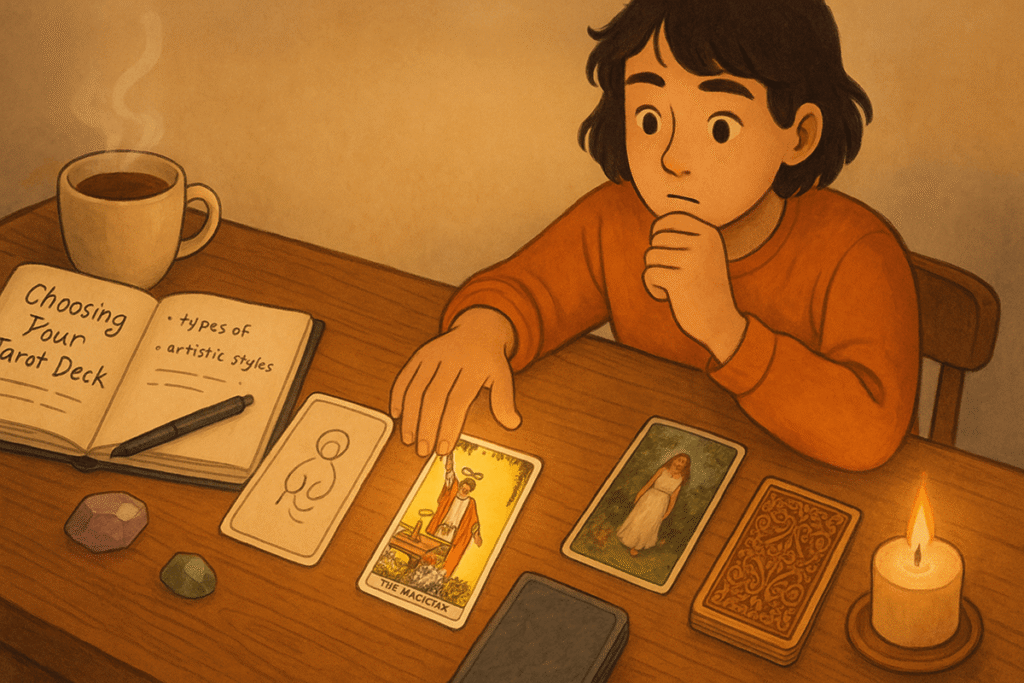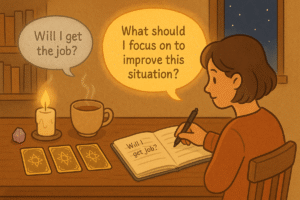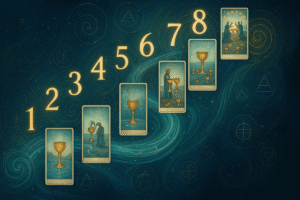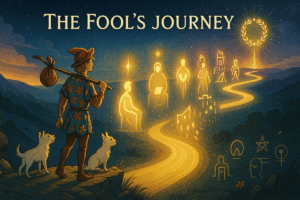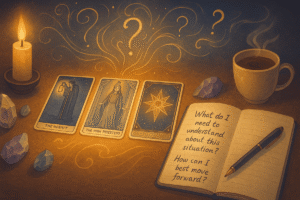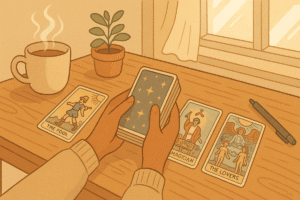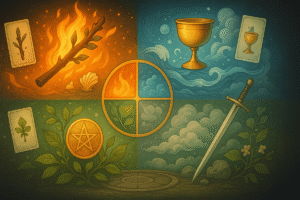Table of Contents
Standing in front of a display of tarot decks for the first time can feel overwhelming. I remember that moment myself – dozens of beautiful boxes, each promising something different, and absolutely no idea where to start. Perhaps you’ve felt that same mixture of excitement and uncertainty. The truth is, there’s no universally “right” first deck, but there are thoughtful ways to approach this choice that can enhance your journey into tarot.
Understanding What You’re Really Choosing
When you choose your first tarot deck, you’re selecting more than just 78 illustrated cards. You’re picking a visual language that will speak to your intuition, a artistic style that resonates with your aesthetic sensibilities, and imagery that might spark different thoughts and feelings during your practice.
Think about it this way – every deck is like a different lens through which to view the same fundamental concepts. The Rider-Waite-Smith tradition might show The Fool as a young person stepping toward a cliff, while a more modern deck could depict this energy as an astronaut floating in space. Both represent new beginnings and taking leaps of faith, but they might evoke different feelings or insights for different people.
What draws you to tarot in the first place? Some people are attracted to the rich symbolism and historical connections. Others appreciate the artistic beauty of the cards. Many find the practice of reflection and introspection appealing. Your motivation might help guide your deck choice, though I think it’s worth being open to surprises along the way.
The Classic Choice: Why Rider-Waite-Smith Remains Popular
The Rider-Waite-Smith deck (sometimes just called Rider-Waite) has been the go-to recommendation for beginners for decades, and there are solid reasons for this. Created in 1909 by artist Pamela Colman Smith under the direction of Arthur Edward Waite, it established many of the visual conventions that modern tarot follows.
What makes it particularly beginner-friendly is the detailed imagery on all 78 cards, including the Minor Arcana. Earlier tarot decks often showed only suit symbols on the numbered cards – imagine trying to interpret the meaning of a simple image of five cups without any narrative context. Smith’s innovation was to create full scenes that tell stories, making the cards more accessible to intuitive interpretation.
The symbolism draws from various traditions – Christian mysticism, Kabbalah, astrology, and classical mythology – creating a rich tapestry of meaning. But perhaps more importantly for beginners, it’s the deck that most tarot books and resources reference. When you’re learning and want to look up a card meaning, chances are the description will be based on the Rider-Waite-Smith imagery.
That said, popularity doesn’t automatically make it the right choice for everyone. Some find the early 20th-century artistic style dated, or the symbolism too esoteric. And honestly, that’s perfectly valid.
Exploring Your Artistic Preferences
I’ve noticed that people often underestimate how much the artwork matters in their tarot practice. You’ll be looking at these images regularly, so it’s worth considering what kind of art speaks to you. Do you gravitate toward realistic illustrations, abstract designs, or perhaps something more whimsical?
Some decks embrace minimalism – clean lines, simple imagery, plenty of white space. The Wild Unknown, for instance, uses stark black and white illustrations with occasional pops of color. Others are maximalist, cramming every card with intricate details and rich symbolism like the Golden Dawn or Hermetic Tarot.
Color psychology plays a role too, though this gets into more personal territory. Warm, earthy tones might feel grounding and comfortable to some people, while others are drawn to cooler blues and purples, or perhaps the drama of high contrast black and white designs.
Cultural representation is increasingly important to consider as well. The tarot world has expanded far beyond its European origins, with decks celebrating diverse cultural perspectives and artistic traditions. This isn’t just about political correctness – it’s about finding imagery that resonates with your own background and experiences.
Size, Quality, and Practical Considerations
Here’s something guidebooks don’t always mention: the physical characteristics of your deck matter more than you might expect. Standard tarot cards are larger than regular playing cards, and some decks are even bigger. If you have smaller hands, or plan to shuffle frequently, this could influence your comfort level.
Card stock quality varies significantly between publishers. Some decks feel flimsy and bend easily, while others are sturdy enough to withstand regular use for years. The finish matters too – some cards have a smooth, glossy coating that shuffles easily, while others have a more textured feel.
I think there’s something to be said for visiting a physical store if possible, just to get a sense of how different decks feel in your hands. Online shopping is convenient, but it can’t replicate the tactile experience of handling the cards.
Price is obviously a factor for many people. Decks range from under $20 to over $100, depending on the publisher, printing quality, and whether they include additional materials like books or special packaging. More expensive doesn’t necessarily mean better for your purposes, though very cheap decks sometimes compromise on image quality or durability.
Beyond the Standard: Alternative Approaches
While the 78-card structure is traditional, some creators have experimented with different approaches that might appeal to beginners. Oracle decks typically have fewer cards and less rigid structure, which can feel less intimidating when you’re starting out. They’re not technically tarot, but they serve a similar reflective function.
Some modern tarot creators have reimagined the traditional meanings entirely, keeping the structure but updating the concepts for contemporary life. These might resonate with people who find historical tarot symbolism too removed from their daily experience.
Themed decks – focused on specific interests like crystals, goddesses, or even popular culture – can provide an entry point for people who might otherwise feel disconnected from traditional tarot imagery. I’ve seen people connect deeply with decks based on their favorite movies, books, or artistic movements.
The Digital Question: Apps vs. Physical Cards
This is where I might contradict myself slightly. Earlier I emphasized the importance of physical characteristics, but digital tarot apps have become incredibly sophisticated. They offer convenience, often include detailed guidebooks, and can be a low-cost way to explore different decks before investing in physical copies.
However, I personally find something lost in translation with digital cards. The ritual of shuffling, the random way cards sometimes stick together or fall out of the deck, the gradual wear patterns that develop on frequently drawn cards – these physical elements contribute to the overall experience in ways that might be more significant than they initially appear.
Perhaps the ideal approach is using digital versions for exploration and physical cards for regular practice, though everyone’s preference will be different.
Making the Decision: Trusting Your Instincts
After considering all these factors, you might still feel uncertain about which deck to choose. That’s normal, and perhaps it’s even appropriate. The process of choosing itself can be part of your tarot journey – an exercise in trusting your intuition and being comfortable with ambiguity.
Here’s what I’ve observed works well for many beginners: start with whatever deck genuinely appeals to you visually, regardless of recommendations. If you find yourself repeatedly drawn to a particular deck’s artwork, that attraction probably means something. Your subconscious might be responding to visual elements that will enhance your practice in ways you can’t yet articulate.
Don’t worry too much about making the “wrong” choice. Many people end up collecting multiple decks over time, and each one can offer different insights or suit different moods and situations. Your first deck doesn’t have to be your only deck, or even your favorite deck forever.
Starting Your Practice: What Comes Next
Once you’ve chosen your first tarot deck, the real exploration begins. Take time to simply look through all the cards without trying to memorize meanings or perform readings. Notice which images catch your attention, which ones you’re drawn to, and which ones make you feel uncomfortable or confused.
Consider keeping a journal of your observations and experiences. How do different cards make you feel? What personal associations do you develop with specific imagery? This reflective practice is often more valuable than memorizing traditional card meanings from books.
Remember that tarot is ultimately a tool for self-reflection and exploration. There’s no right or wrong way to use it, and your relationship with your deck will likely evolve over time. The most important thing is approaching it with curiosity and openness to whatever insights might emerge.
Some people like to “cleanse” or “consecrate” their new deck through various rituals, while others simply start using them immediately. Both approaches are valid – do whatever feels meaningful to you, or nothing at all if that feels right.
Conclusion: Embracing the Journey
Choosing your first tarot deck is really about beginning a conversation – with yourself, with the imagery, with whatever questions and reflections emerge from your practice. The specific deck you choose matters less than your willingness to engage thoughtfully with the process.
I think the beauty of tarot lies not in its ability to predict the future, but in its capacity to help us notice patterns, explore possibilities, and ask ourselves deeper questions. Your first deck is simply the beginning of that exploration. Whether you end up with a classic Rider-Waite-Smith, a contemporary reimagining, or something completely unexpected, what matters most is that it speaks to you and supports your journey of self-discovery.
Trust your instincts, be patient with yourself as you learn, and remember that every expert was once a beginner holding their first deck and wondering where to start.
Frequently Asked Questions
Do I have to wait for someone to gift me my first tarot deck?
This is probably the most persistent myth in the tarot world, and I’m happy to say it’s completely untrue. The belief that your first deck must be gifted to you is a relatively recent superstition with unclear origins, and many experienced tarot readers consider it “total rubbish.” If you waited around for someone to gift you a deck, you might never start your tarot journey – especially if your friends and family aren’t familiar with tarot.
The reality is that choosing your own deck allows you to select one that truly resonates with you personally. Many tarot experts note that decks they’ve been gifted often end up sitting unused in drawers precisely because they weren’t chosen with care. Your connection to the deck matters far more than how it comes into your possession.
How do I know if a deck is right for me?
This question doesn’t have a simple answer, and perhaps that’s the point. Many readers describe feeling called to certain decks, as if particular cards “speak” to them or resonate with something deeper. When you’re browsing decks, pay attention to which imagery captures your attention repeatedly.
If you can visit a physical store, take advantage of the opportunity to handle different decks. How the cards feel in your hands, the weight of the card stock, and whether you can shuffle them comfortably all contribute to your experience. If shopping online, look for sites with detailed images and reviews. Some readers suggest looking through as many cards from a deck as possible before purchasing to ensure the overall aesthetic and symbolism resonate with you.
Is Rider-Waite-Smith really the best deck for beginners?
It depends on what “best” means to you. The Rider-Waite-Smith deck is recommended for beginners primarily because most tarot resources, books, and websites reference its imagery when explaining card meanings, making learning more straightforward. The detailed scenes on all 78 cards provide visual cues that can help with intuitive interpretation.
However, “best” for learning isn’t the same as “best” for you specifically. Some readers develop profound practices with decks outside the traditional systems because they feel deeply connected to the imagery. If the Rider-Waite-Smith aesthetic doesn’t appeal to you, consider getting a deck you’re genuinely excited about along with its accompanying guidebook. Your enthusiasm for working with the cards often outweighs the convenience of standardized resources.

